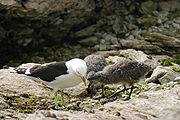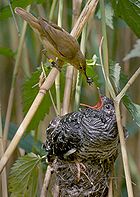
Fixed action pattern
Encyclopedia

Ethology
Ethology is the scientific study of animal behavior, and a sub-topic of zoology....
, a fixed action pattern (FAP), or modal action pattern, is an instinct
Instinct
Instinct or innate behavior is the inherent inclination of a living organism toward a particular behavior.The simplest example of an instinctive behavior is a fixed action pattern, in which a very short to medium length sequence of actions, without variation, are carried out in response to a...
ive behavior
Behavior
Behavior or behaviour refers to the actions and mannerisms made by organisms, systems, or artificial entities in conjunction with its environment, which includes the other systems or organisms around as well as the physical environment...
al sequence that is indivisible and runs to completion. Fixed action patterns are invariant and are produced by a neural network
Biological neural network
In neuroscience, a biological neural network describes a population of physically interconnected neurons or a group of disparate neurons whose inputs or signalling targets define a recognizable circuit. Communication between neurons often involves an electrochemical process...
known as the innate releasing mechanism in response to an external sensory
Sensory system
A sensory system is a part of the nervous system responsible for processing sensory information. A sensory system consists of sensory receptors, neural pathways, and parts of the brain involved in sensory perception. Commonly recognized sensory systems are those for vision, hearing, somatic...
stimulus known as a sign stimulus or releaser (a signal
Signalling theory
Within evolutionary biology, signalling theory is a body of theoretical work examining communication between individuals. The central question is when organisms with conflicting interests should be expected to communicate "honestly"...
from one individual to another). A fixed action pattern is one of the few types of behaviors which can be said to be hard-wired and instinctive
Instinct
Instinct or innate behavior is the inherent inclination of a living organism toward a particular behavior.The simplest example of an instinctive behavior is a fixed action pattern, in which a very short to medium length sequence of actions, without variation, are carried out in response to a...
.
Examples

Bird
Birds are feathered, winged, bipedal, endothermic , egg-laying, vertebrate animals. Around 10,000 living species and 188 families makes them the most speciose class of tetrapod vertebrates. They inhabit ecosystems across the globe, from the Arctic to the Antarctic. Extant birds range in size from...
s, are examples of fixed action patterns. In these cases, the sign stimulus
Stimulus (physiology)
In physiology, a stimulus is a detectable change in the internal or external environment. The ability of an organism or organ to respond to external stimuli is called sensitivity....
is typically the presence of the female.
Another example of fixed action patterns is aggression towards other males during mating season in the red-bellied stickleback
Stickleback
The Gasterosteidae are a family of fish including the sticklebacks. FishBase currently recognises sixteen species in the family, grouped in five genera. However several of the species have a number of recognised subspecies, and the taxonomy of the family is thought to be in need of revision...
. A series of experiments carried out by Niko Tinbergen showed that the aggressive behavior of the males is a FAP triggered by anything red, the sign stimulus. The threat display of male stickleback
Stickleback
The Gasterosteidae are a family of fish including the sticklebacks. FishBase currently recognises sixteen species in the family, grouped in five genera. However several of the species have a number of recognised subspecies, and the taxonomy of the family is thought to be in need of revision...
is also a fixed action pattern triggered by a stimulus.
Another well known case are the classic experiments by Tinbergen and Lorenz
Konrad Lorenz
Konrad Zacharias Lorenz was an Austrian zoologist, ethologist, and ornithologist. He shared the 1973 Nobel Prize with Nikolaas Tinbergen and Karl von Frisch...
on the Graylag Goose. Like similar waterfowl
Waterfowl
Waterfowl are certain wildfowl of the order Anseriformes, especially members of the family Anatidae, which includes ducks, geese, and swans....
, it will roll a displaced egg
Egg (biology)
An egg is an organic vessel in which an embryo first begins to develop. In most birds, reptiles, insects, molluscs, fish, and monotremes, an egg is the zygote, resulting from fertilization of the ovum, which is expelled from the body and permitted to develop outside the body until the developing...
near its nest back to the others with its beak. The sight of the displaced egg triggers this mechanism. If the egg is taken away, the animal continues with the behavior, pulling its head back as if an imaginary egg is still being maneuvered by the underside of its beak. However, it will also attempt to move other egg shaped objects, such as a golf ball, door knob, or even an egg too large to have possibly been laid by the goose itself (a supernormal stimulus).
Other examples include:
- Kelp GullKelp GullThe Kelp Gull , also known as the Dominican Gull, breeds on coasts and islands through much of the southern hemisphere. The race L. d. vetula occurs around southern Africa, and nominate L. d...
chicks are stimulated by a red spot on the mother's beak to peck at spot, which induces regurgitation.
- Some mothMothA moth is an insect closely related to the butterfly, both being of the order Lepidoptera. Moths form the majority of this order; there are thought to be 150,000 to 250,000 different species of moth , with thousands of species yet to be described...
s instantly fold their wings and drop to the ground if they encounter ultrasonic signals such as those produced by batBatBats are mammals of the order Chiroptera "hand" and pteron "wing") whose forelimbs form webbed wings, making them the only mammals naturally capable of true and sustained flight. By contrast, other mammals said to fly, such as flying squirrels, gliding possums, and colugos, glide rather than fly,...
s; see ultrasound avoidanceUltrasound avoidanceUltrasound avoidance is an escape or avoidance reflex displayed by certain animal species that are preyed upon by echolocating predators. Ultrasound avoidance is known for several groups of insects that have independently evolved mechanisms for ultrasonic hearing...
.
- Mayflies drop their eggs when they encounter a certain pattern of light polarization which indicates they are over water.
Significance
A FAP is significant in animal behavior because it represents the simplest type of behavior, in which a readily defined stimulus nearly always results in an invariable behavioral response. A FAP can truly be said to be "hard-wired." FAPs are also unusual, in that most behaviors are modulated by the environment; a fixed response can lead to maladaptive results, whereas flexible behaviors are generally more useful. Because of this, most behaviors which are both FAPs and occur in more complex animals are usually essential to the animal's fitness or in which speed is a factor. For instance, the Greylag Goose's egg rolling behavior is so essential to the survival of its chicks that its fitness is increased by this behavior being hard-wired. A chick which cannot consistently feed will die. A moth's response to encountering echolocation needs to be immediate in order to avoid predation. An attacking stickleback is placed at an advantage if it reacts quickly to a threat. However, because these behaviors are hard-wired, they are also predictable. This can lead to their exploitation by humans or other animals.Exploitation

Starvation
Starvation is a severe deficiency in caloric energy, nutrient and vitamin intake. It is the most extreme form of malnutrition. In humans, prolonged starvation can cause permanent organ damage and eventually, death...
.
General
- Alcock, J.John Alcock (behavioral ecologist)John Alcock is an American behavioral ecologist and author. He is currently the Emeritus' Professor in the School of Life Sciences at Arizona State University. His research interests include the evolution of diversity in insect populations, studying the adaptive value of different ways in which...
(1998) Animal Behavior: An Evolutionary Approach (6th edition), Chapter 5. Sinauer Associates, Inc. Sunderland, Massachusetts. ISBN 0-87893-009-4 - James E. Mazur (2005) Learning and Behavior, (6th Edition]. New Jersey: Prentice Hall. ISBN 978-013-193163-3

